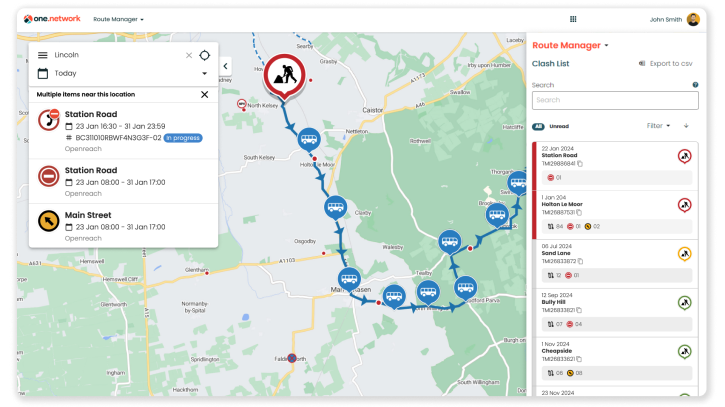05 February 2024
Revamping Route Manager: helping authorities and operators protect bus routes and improve reliability

In the face of UK objectives to encourage modal shift and reach Net Zero by 2050, the English government developed a Bus Back Better strategy to improve bus operations. Similarly, in Wales, the National Transport Delivery Plan 2022-2027 outlines plans to enhance bus services to meet local needs and support national targets.
Now, the onus falls on highway authorities and bus operators to make bus journeys more reliable and efficient for passengers. Critical to these efforts is the implementation of robust tools capable of transforming plans into actionable results.
Here at one.network, we’ve invested in developing and enhancing our Route Manager module to better support these initiatives. With this solution, highway authorities and bus operators can visualise their bus routes on the one.network map, enabling automatic clash detection between roadworks and bus routes. Changes to routes can be planned and shared across teams and organisations, providing a real-time view of the impact on traffic flow and streamlining collaboration.
The improvements we’ve made are helping authorities such as Blackburn with Darwen Borough Council, Kent County Council and West Sussex County Council to protect their bus routes from disruptions and delays caused by roadworks and road events. By categorising types of clashes as severe, medium or low impact, Route Manager gives them rapid insight into the likely level of impact any clashes are to have on routes. This empowers them to adjust routes and plan effective and efficient diversions ahead of time, ensuring routes run more reliably. Not only does this help commuters and the public reach their destinations on time, but additionally, it ensures school bus services run swiftly and smoothly.
We've also been collaborating closely with Transport for London and operators like London United Busways (RATPDev), to transform their bus services. London United Busways use Route Manager to identify clashes along their bus routes and plan effective diversions. This helps them reduce Excess Waiting Time (EWT), offering more efficient and consistent services for passengers, as well as limiting penalties received for service disruption.
Let's dig into the improvements:
Enhancing route planning with future clash detection
In 2022, Route Manager became more intelligent with the addition of future clash detection. With the power to identify clashes between roadworks and routes that are scheduled in the future, users are better able to prepare for disruption by planning and communicating effective diversions ahead of time.
We also added enforcement patterns for bus routes, allowing for the creation of bus routes which are only in force on certain days or at certain times.
Further developments made in 2022 were:
- Enhanced clash performance, making loading and filtering clashes between roadworks and bus routes much faster.
- Documents and email alert functionalities for formal, regulated tracking and communication of changes to bus routes.
- Search support for clashes.
- A copy feature, enabling users to copy existing bus routes and diversions.
- The ability to add road names, towns, counties, districts and post codes to bus route diversion and temporary bus stop documentation, post-submission.
- Arrows added on routes to indicate the direction of the route.
- A new bus stop dashboard widget, displaying the number of bus stops.
- Introduction of ACTO and NaPTAN codes to bus stops, helping users more easily identify bus stops and which authority they fall under.
Making clash detection faster & simpler
Previously where any clashes between roadworks and bus routes would have been presented separately, Auto Classification links associated disruptions, presenting them as individual clashes. For example, where a road has been closed for street works, the road closure and street works will now be presented as one clash rather than two separate ones.
In addition, we made some usability improvements:
- Smoother scrolling and panning the map when using Route Manager
- A new centre on map button to help centre the map back on the selected bus route after navigating way.
How are one.network customers using Route Manager to meet their bus service objectives?
Here are just a few of the ways in which Route Manager is equipping users to rise to their bus service improvement objectives:
- Proactive Conflict Detection: Earlier identification of roadworks that are disrupting bus routes. Authorities are using the solution to identify disruptive road activity along their routes and rapidly implement efficient diversions. This diminishes the need for manual monitoring and helps reduce EWT for passengers .
- Dynamic Route Planning: Real-time route planning capabilities are allowing for immediate analysis of traffic flow impact. With enhanced visibility of the impact of diversions on journey times, authorities are better able to protect important bus routes such as school bus services.
- Seamless Communication: Easier and more efficient collaboration between highway authorities and bus operators, ensuring everyone is in the loop when routes undergo modifications. Transport for London, as part of its Bus Sense project, is working with several London boroughs to coordinate more consistent and efficient bus services across the city.
- Evidence-Driven Improvements: Route Manager keeps tracks of all changes to bus routes, providing concrete evidence of service upgrades and justifying future strategic directions.
It’s clear that Route Manager is more than just an easy solution; it's a catalyst for the change that is necessary for more reliable bus services and a more sustainable future. Empowered by this tool, highway authorities and bus operators are set to make significant strides towards achieving their targets. Want to learn more? Get in touch.